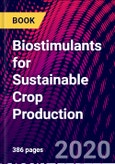`This book is what a review should be…a complete book on a hugely relevant topic…It is a preview of a new era in agricultural development that brings excitement and vast potential to tackle the challenge of feeding a growing population sustainably.` Review in Bio Based Press `In addition to being well written and structured, this book is edited by some of the most prominent authors in the field of biostimulants…It meets the need for a reliable and comprehensive review on current legislation, challenges and peer-reviewed scientific results… a comprehensive guide to the potential roles of the different biostimulant categories in sustainable agriculture.` Chronica Horticulturae With increasing concerns about the environmental impact of fertilizers, there is a growing need for the sector to develop more sustainable, ‘climate-smart’ methods of crop production. Biostimulants have attracted growing attention since they offer the potential to enhance yields through stimulating natural processes in crops. Biostimulants for sustainable crop production provides a comprehensive review of the key advances in understanding and using biostimulants. This collection covers the major groups of biostimulants, from humic substances and seaweed extracts to protein hydrolysates and plant growth-promoting rhizobacteria (PGPR), as well as the practical application of biostimulants in areas such as enhancing nutrient use efficiency (NUE). With its distinguished editors and international range of expert authors, Biostimulants for sustainable crop production will be a standard reference for those researching crop nutrition, government and other bodies supporting more sustainable agriculture as well as agronomists and farmers.
Audience: University researchers in crop nutrition and agronomy; government and other bodies supporting organic and other forms of more sustainable agriculture; agrochemical companies supplying crop nutrition products; commercial agronomists and farmers interested in the science behind biostimulants.
Audience: University researchers in crop nutrition and agronomy; government and other bodies supporting organic and other forms of more sustainable agriculture; agrochemical companies supplying crop nutrition products; commercial agronomists and farmers interested in the science behind biostimulants.
Table of Contents
Part 1 Introduction and biostimulant characterization
Part 2 Non-microbial and microbial categories of biostimulants
Part 3 Innovation and practical applications








